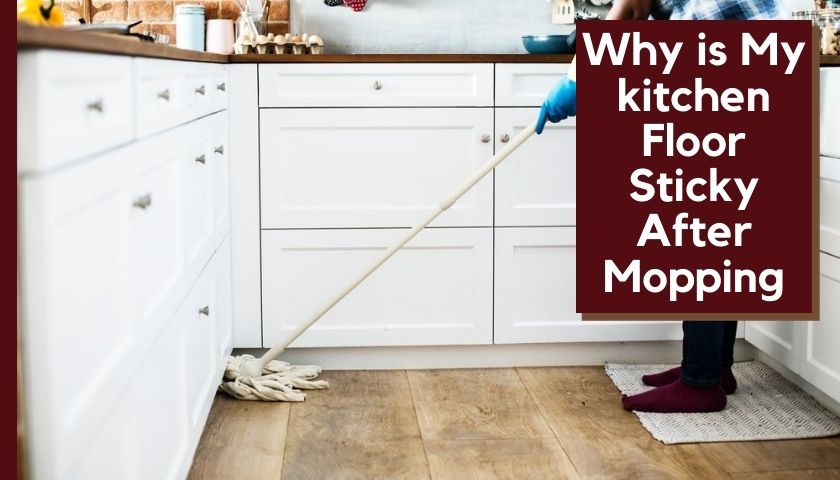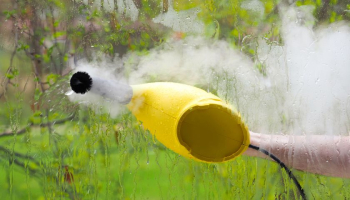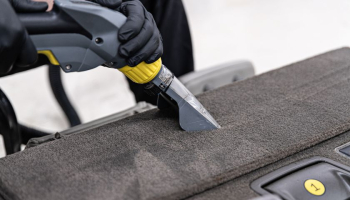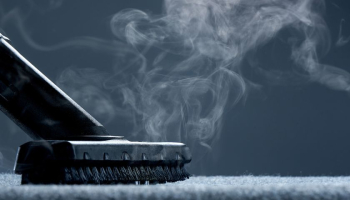Sticky Floors After Mopping | How to Get Rid of Sticky Floors After Mopping

Mopping is one of the regular household chores that need to make your floor clean and bright. The kitchen is the most used place in the house where cooking oil and spices are spilled on the floor and make dirty quickly. That is why moping is essential for cleaning the floors, including the kitchen floor. But often, some mistakes can cause kitchen floors as well as other floors sticky even after mopping.
When you walk very fast on the floor, you will find that the floor feels sticky. Even there can be a telltale sound under your foot or shoes as the floor is sticky enough. If you also often suffer from this problem, then this post will help you to know the prime causes and clean your kitchen floor, including other floors, properly.
Contents
Why is My Floor Sticky After I Mop?
It is essential to find out the sources to fight against the problem. Just like that, once you figure out the causes of this annoying stickiness, then you can easily find the solution. Here are several common causes.
1. Stubborn residue
The stubborn residue is the prime reason for the stickiness on the floor after mopping. This residue left behind some adhesive substance, such as grease, glue, and soft drink, which can be attached to your floor and create stickiness.
On the kitchen floor, the grease is released by the pan-frying and drops on the floor. This grease comes in contact with other chemicals, creates an oxidizing reaction, and causes stickiness on the floor.
In winter, salt and calcium chloride, often dissolved into water, gets sticky on the kitchen and dining floor. A normal mopping cannot remove these stains and turn them into a stubborn residue.
2. Wrong cleaning technique
We know house cleaning is an easy task, but it doesn’t mean you just dip the mop into water or whatever chemical cleaner and move around the floor. Your wrong cleaning technique can also leave stickiness on the floor.
Maybe you do not squeeze the mop head properly to remove excess water and start mopping the floor. The wets too much and take much time to dry. As a result, they become sticky.
3. Choose the wrong cleaner
It is another most happened cause for the kitchen floor being still sticky after mopping. Buy the wrong cleaner is the most common mistake, which often leaves more residue on the floor than others.
You should have a clear idea about your floor types then you should buy the appropriate floor cleaner which will suit your floor the best.
4. Use too strong and too much floor cleaner
You may know that each chemical cleaner comes with specific instructions regarding the use. If you take too much cleaner, then you may have to face a sticky floor disaster. If your cleaner contains soapy elements, your cleaning area gradually dries and causes the residue to leave behind.
Sometimes we take too strong a chemical cleaner, which also tough to remove from the floor completely by a single mopping. These chemicals also can reduce the floor’s firmness and shorten durability.
5. Clean with dirty water
When you use a regular mop, you need to use a lot of water because the more you will mop, the dirtier the bucket water becomes. Once you notice the bucket water’s color turn dark, you just need to replace it with clean water. Otherwise as long as you continue mopping with dirty water, it will continue to make your floor sticky.
If you are also suffering from this problem, you can use a sping mop. A spin mop removes as much dirt from the mop head as possible so that you take less time and minimum effort to change the dirty water.
How Do You Get Rid of Sticky Floors After Mopping?
The good news is that the kitchen floor’s stickiness does not stay forever, and it is easy to remove. If you also have a sticky floor, then go for the following cleaning methods.
1. Do some more mopping
If you notice stickiness on the floor, then the easiest way to remove it is to more mop your floor. Just simply take water on the bucket and mop the floor again. If you feel clean water can not remove the residue properly, you can use any other cleaning solutions. But never use any strong chemical cleaner again. Maybe this time, a little vinegar or baking soda will enough for cleaning your kitchen floor.
2. Go for the steam mop
If possible, you should use a steam mop instead of a traditional mop. A steam mop is very effective in cleaning stubborn stains and dirt. It releases hot steam and softens the stain within a few seconds to remove. But never forget to check the user instruction for your floor. You may need to adjust the power of steam to protect your floor from damage because the hot steam can break down the grout lines.
3. Choose a residue-free cleaner
It is another easy way to get rid of sticky floors. You should choose a less-residue or residue-free cleaner household. However, if you clean residue by moor mopping, then the problem will be solved, but it will a temporary solution. You just check your floor and pick a suitable residue-free cleaner to clean the floor.
4. Use dilution control
As we already said that, an excessive amount of cleaning product could leave behind a sticky residue. So, only use the right amount of cleaning product by following the user’s instructions. Remember that excess floor cleaner can damage your flooring.
5. Wash and rinse the mop
Yes, don’t be surprised. You should wash, rinse, and dry the mop before you store it. Only a clean mop can do wonders in removing floors. If your floor is relatively clean, one bucket of water is enough for mopping the entire floor. However, if water gets dirty, then replace it immediately with clean water.
Wrapping up
We hope this post will help you find out why your kitchen floor sticky after mopping. Once you find out the reason, follow the above-listed cleaning tips and remove the stubborn residue from the floor. Don’t forget to check your floor sensitivity before using any chemical or tool to prevent unwanted damage. All the best.
Frequently Asked Questions (FAQs)
How do I make my wood floor less sticky?
- Take one gallon of water and pour one cup of vinegar into it. Mix them well.
- Remove all debris, messes, and sweep away the floor start mopping.
- A sponge or a cotton mop is enough to remove floor’s stickiness.
- However, dip the mop head into the cleaning solution and start mopping.
What can I use for the sticky floor?
You can take warm or hot water and add a half cup of household ammonia into it. Wet the mop using this cleaning solution and start mopping the floor. Once the water becomes darker, take another bucket of clean water, add ammonia, and then continue your mopping.
Can I use vinegar to clean my sticky kitchen floor?
Yes. Vinegar is excellent in removing the stickiness of flooring.
Can I use rubbing alcohol to get rid of sticky residue?
Yes, rubbing alcohol is very effective in removing stains and stickiness from the floor.






![How to Attach a Swiffer Wet Pad? [Learn to Do It Correctly]](https://mopsreview.com/wp-content/uploads/thumbs_dir/How-to-Attach-Swiffer-Wet-Pad-20ohih1eaj9c1n0speeheg51u8ulaobz5p513g7q9y90.jpg)

